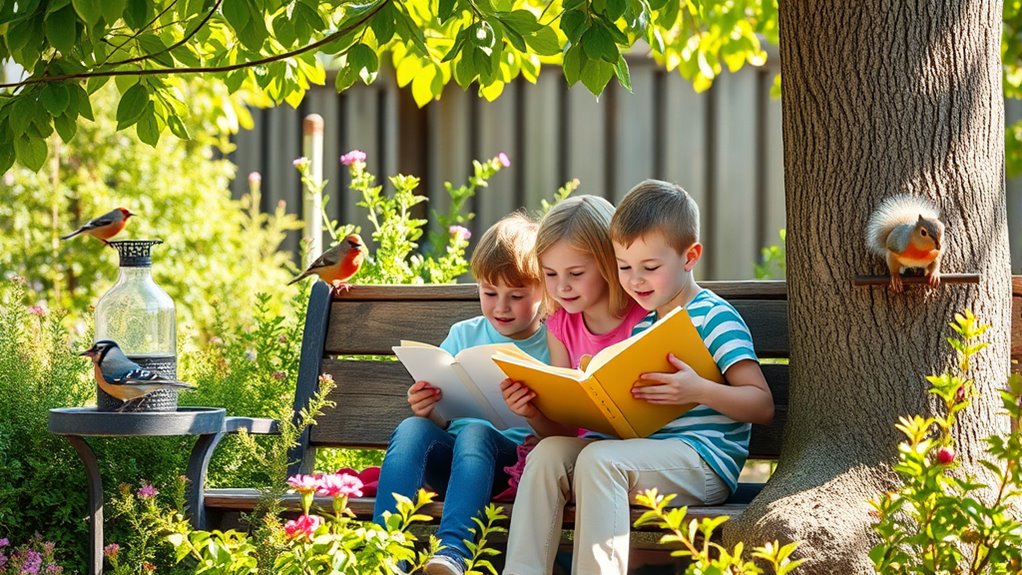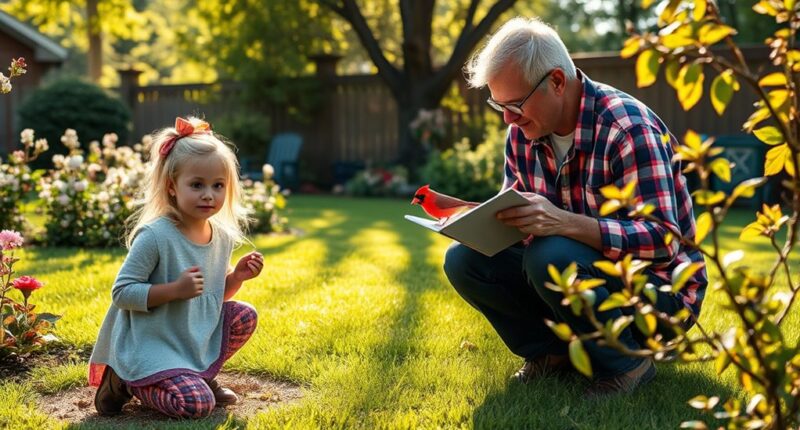Starting backyard birding with your family is a fun way to connect with nature and teach children about local birds. Use a family journal to record sightings, behaviors, and seasonal changes, which deepens understanding and creates memories. Place feeders thoughtfully, offer a variety of foods, and keep notes on how birds respond. Patience and consistency help attract different species throughout the year. Keep exploring new ideas to make your birding experience even richer.
Key Takeaways
- Use a family nature journal to record bird species, behaviors, and seasonal changes observed in your backyard.
- Encourage children to sketch birds and note their visits, fostering curiosity and learning.
- Track how different feeder placements and foods attract various bird species over time.
- Observe weather and seasons to understand their effects on bird activity and migration patterns.
- Make journaling a regular family activity to deepen connections with local wildlife and promote ongoing engagement.

If you’re just starting out with backyard birding, there’s no better time to begin than today. Setting up your space thoughtfully can make a big difference in attracting a variety of birds. One of the most important steps is bird feeder placement. Position your feeders in quiet, sheltered spots that are visible from windows, but away from busy walkways or areas where cats or other predators might lurk. Hanging feeders near shrubs or trees offers birds a quick escape route if they feel threatened. Keep in mind that different bird species have different preferences; some like hanging feeders, while others prefer platform or ground feeders. Experimenting with placement can help you discover what attracts the most visitors.
As you observe, you’ll notice seasonal bird behaviors that change throughout the year. During spring and summer, many birds are busy nesting and raising their young. They’ll visit feeders more frequently during these times, often seeking high-energy foods like sunflower seeds and suet. In fall, birds prepare for migration, and you’ll see an increase in species passing through your yard. Offering a variety of seeds and fruits can support their energy needs. Winter, on the other hand, often brings a surge in birds because natural food sources are scarce. During this season, keeping your feeders stocked and clean becomes even more *vital*. You might also notice some species sticking around year-round, while others come and go with the seasons.
As you watch seasonal shifts, consider keeping a family nature journal to record what you see. Noticing how bird activity varies with the weather and seasons deepens your connection with your backyard ecosystem. Use your journal to identify different species, note their behaviors, and track how your feeder choices influence which birds visit. This practice encourages curiosity and helps you become more attuned to the natural world. Remember, patience is key; some birds may take time to discover your feeders or may only appear during certain times of the year. Consistency in feeder placement and offering a variety of foods will gradually attract a diverse array of visitors.
Frequently Asked Questions
What Are the Best Times of Day for Backyard Birding?
The best times of day for backyard birding are early morning and late afternoon when birds are most active. During these times, you’ll notice more bird song identification and see a variety of species. Place your bird feeders strategically to attract them during these peak hours. Keep quiet and patient, and you’ll enjoy observing their behaviors, making your birding experience more rewarding.
How Can I Attract Rare Bird Species to My Yard?
To attract rare bird species, you need to focus on strategic bird feeder placement and native plant selection. Place feeders in quiet, sheltered spots away from predators, and choose native plants that provide natural food sources. You’ll also want to create a diverse habitat with brush piles, water sources, and flowering plants. By offering the right environment and food, you increase your chances of welcoming rare and beautiful birds to your yard.
What Should I Include in a Family Nature Journal?
In your family nature journal, include sketches or photos of birds, their behaviors, and habitats. Add bird song recordings to help identify different species by sound. Write down nest observation tips, noting nest locations and materials used. Encourage everyone to record their observations, feelings, and questions. This creates a fun, educational record that deepens your connection to local birds and enhances your outdoor adventures together.
How Do I Identify Birds With Similar Appearances?
To identify birds with similar appearances, focus on bird identification details like plumage patterns, size, and shape. Observe their markings carefully, noting differences in wing bars, eye rings, or tail shape. Use binoculars for clearer views, and compare your observations with field guides or apps. Repeatedly observing these traits helps you distinguish between species, making bird identification easier and more enjoyable as you learn to recognize subtle differences.
Are There Safety Tips for Observing Birds With Children?
Yes, there are safety tips for observing birds with children. Always supervise your child closely to prevent wandering off or getting too close to potentially dangerous wildlife. Keep a safe viewing distance to avoid startling birds or causing them stress. Use binoculars to see birds clearly without getting too near. Teach children to be gentle and respectful of nature, ensuring a fun and safe experience for everyone involved.
Conclusion
Now that you’ve started backyard birding, you’re like a detective uncovering nature’s secrets right outside your door. Keep your journal handy and observe each feathered visitor with curiosity and patience. Just as a garden blooms with care, your birding skills will flourish over time. Remember, every sighting is a small victory—each one brings you closer to understanding your feathered friends. So go ahead, embrace the adventure and enjoy the lively symphony of your backyard!








